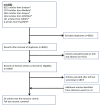Role of Alternative Medical Systems in Adult Chronic Kidney Disease Patients: A Systematic Review of Literature
- PMID: 36694496
- PMCID: PMC9867890
- DOI: 10.7759/cureus.32874
Role of Alternative Medical Systems in Adult Chronic Kidney Disease Patients: A Systematic Review of Literature
Abstract
There is a growing interest in the use of alternative medical systems (AMS), such as traditional Chinese medicine (TCM), ayurveda, homeopathy, and naturopathy, among chronic kidney disease patients. This review summarizes the efficacy and safety of AMS interventions in chronic kidney disease (CKD) patients. A systematic review was conducted in MEDLINE, Embase, Scopus, CINAHL, CENTRAL, and PsycINFO in line with the Preferred Reporting Items for Systematic Reviews and Meta-Analyses (PRISMA) and Synthesis without meta-analysis (SWiM) guidelines. Randomized controlled trials (RCTs) which evaluated the use of AMS among adult CKD patients were included. The efficacy of each AMS was assessed based on improvement in biochemical markers or reduction in symptom severity scores. All adverse reactions were recorded. Of the 14,583 articles retrieved, 33 RCTs were included. TCM (n=20) and ayurveda (n=6) were the most well-studied. Majority of studies (66.7%) had a sample size <100. Common indications evaluated included improvement in renal function (n=12), proteinuria (n=5), and uremic pruritus (n=5). Among TCM, acupuncture and syndromes-based TCM granules formulation were shown to improve estimated glomerular filtration rate (eGFR) by 5.1-15.5% and 7.07-8.12% respectively. Acupuncture reduced uremic pruritus symptoms by 54.7-60.2% while Huangkui, Shenqi granules, and Tripterygium wilfordii Hook F reduced proteinuria by 18.6-50.7%, 61.8%, and 32.1% respectively. For Ayurveda, camel milk and Nigella sativa oil improved eGFR by 16.9% and 86.8%, respectively, while capsaicin reduced pruritus scores by 84.3%. Homeopathic verum medication reduced pruritus scores by 29.2-41.5%. Nausea was the most common adverse effect reported with alpha-keto amino acids (0.07%), Nigella sativa oil (7.04%), and silymarin (10%). TCM and ayurveda were more well-studied AMS therapies that demonstrated efficacy in CKD patients. RCTs with larger sample sizes are needed to ascertain the efficacy and safety of promising AMS.
Keywords: alternative medical systems; chronic kidney diseases; complementary therapies; renal insufficiency; systematic reviews; therapeutics.
Copyright © 2022, Teo et al.
Conflict of interest statement
The authors have declared that no competing interests exist.
Figures
References
-
- Prevalence and disease burden of chronic kidney disease. Lv JC, Zhang LX. Adv Exp Med Biol. 2019;1165:3–15. - PubMed
-
- Efficacy and cost effectiveness of the acupuncture treatment using a new skin stimulus tool called M-test which is a measure based on symptoms accompanied with body movements: a pragmatic RCT targeting hemodialysis patients. Ono S, Mukaino Y. Evid Based Complement Alternat Med. 2015;2015 - PMC - PubMed
-
- The prevalence of symptoms in end-stage renal disease: a systematic review. Murtagh FE, Addington-Hall J, Higginson IJ. Adv Chronic Kidney Dis. 2007;14:82–99. - PubMed
Publication types
LinkOut - more resources
Full Text Sources
Research Materials
Miscellaneous

